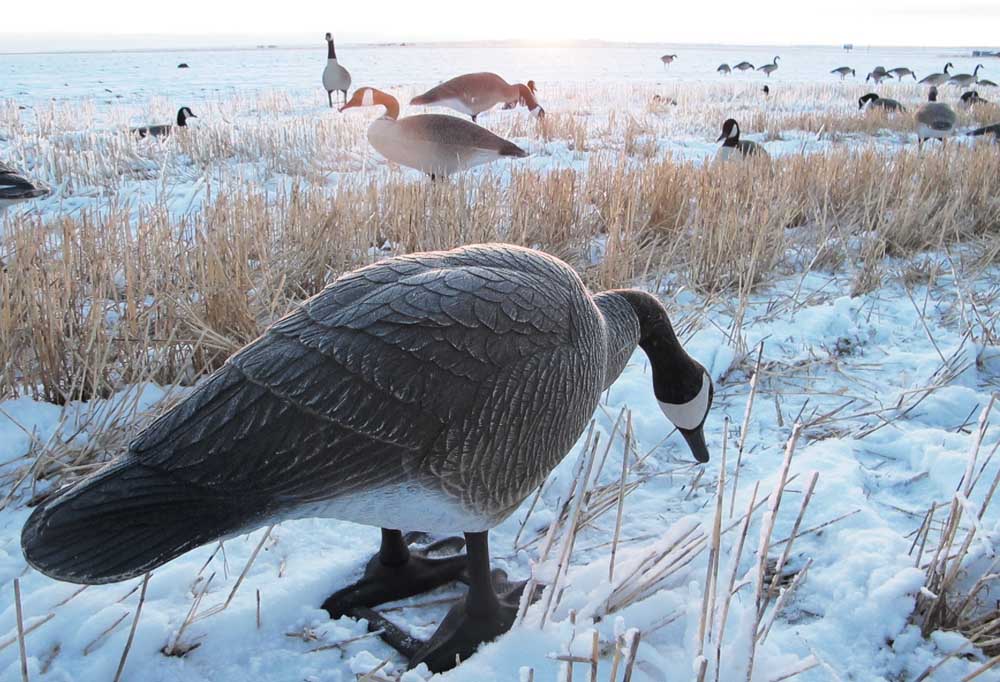The tiresome trials and triumph of a goose hunt
Published 12:00 am Wednesday, February 18, 2015

- Courtesy The Billings (Mont.) GazetteGoose decoys line a field in the morning light. “Hunting is always supposed to be fun,” a veteran waterfowl hunter says.
Larry Webster came in to The Billings Gazette office recently with my work already done for me.
Webster, an avid sportsman who lives on a small ranch near Roberts, Montana, brought in one of my Outdoor pages with his goose hunting photos taped over the top of the newspaper, accompanied by a two-page, neatly handwritten tale titled “Life in a goose blind,” with Larry Tom Webster and Bruce Steffen.
“What’s life like in a goose blind? It all starts with coffee at 5 a.m., checking the weather and waking up the dog, a red phased-yellow Labrador named Honz or Hon Z. Owner Larry Tom Webster of Roberts, is ready for another morning in a goose blind with son-in-law Bruce Steffen of Red Lodge, Montana.”
It was the last week of the goose season when Webster dropped by still wearing his camouflage jacket. He seemed a bit wistful about his hunts ending, wanting to hang on to the memories with his tale.
“You’re always glad when the season is over because your body is worn down,” he confided. “But two days later you’re wishing you could hunt.”
“The Chevy Suburban is loaded the night before with 50 to 110 goose decoys, a shovel and a day pack. Bruce arrives at 5:30, puts his gun and gear in and off we go for a morning of goose hunting. Arriving at one of our blinds in the dark the chore of setting up 100 decoys begins under the lights of the vehicle.”
Webster said he tries to hunt about every third day of the waterfowl season.
“If you hit it every day, you’ll blow them out of there,” he explained. “We don’t even hunt evenings. That’s when they come in to rest.”
They have a variety of goose blinds they use at a number of scattered properties where they’ve gained permission to hunt.
“The whole barn is full of ’em,” Webster said.
His photos show he and Steffen know their stuff. The back of the Suburban is loaded with a limit of 10 Canada geese from one January hunt.
“Yep, we’ve been getting limits,” he said, as if that were a given.
“Anybody that wants them, we give a lot away. And we like ’em, too.”
“With decoys in place, they retire inside the blind for hot coffee and a short wait until legal shooting time. The wait is enjoyable while sitting on padded swivel seats drinking hot coffee. With the arrival of shooting time, two Remington autoloader shotguns are loaded with 3-inch No. 1 steel loads. Ammo is always the choice of hunters. Usually for geese No. 1, BBs or No. 2 loads are most popular to use. We prefer Kent No. 1s in 3-inch size.”
The duo had no trouble finding geese this year, although he said the larger mallard ducks from up north blew through in a hurry during one of the winter’s cold snaps.
“The geese were flying in huge groups, which really makes it hard to bring them in,” he said.
Fooling lots of eyes is much more difficult than fooling a few.
Webster said he appreciated that Fish, Wildlife and Parks split the goose season this year, allowing waterfowlers in the area to hunt later into the year than typical after a weeklong closure.
“Now ready and loaded up, we watch Honz’s ears; he hears the geese coming long before we do. When he cocks his head and ears to one side, we know geese are coming. When the shooting begins, Honz goes out a small 12-inch hole in the bottom of the blind to retrieve fallen birds. Some times five birds will tumble to the ground.”
There’s nothing quite like watching a well-trained hunting dog. Webster brims with pride when he talks about Honz, a British Lab that he purchased from the Bobby Stewart Kennels in Oxford, Mississippi. Honz is 5½ years old, in the prime of his hunting career. But Webster said Honz was a natural, retrieving ducks when he was 4 months old.
Longtime Gazette readers might remember previous stories about Webster. He has a safari-themed man cave he built on to his Roberts home, decorated with trophies that he and his wife, Phyllis, shot on an African hunting trip. He used to manage the Painted Horse Ranch before retiring and devoting a good share of his newly free time to outdoor activities as well as volunteering with the local Ducks Unlimited chapter.
He estimated he had been hunting waterfowl about 25 years.
“Enjoy your hunt, enjoy a good hunting dog and hunt safe. Remember, booze and bullets don’t mix. Hunting is always supposed to be fun.”
People sometimes ask me where I get ideas for stories. The traditional answers are from attending meetings, reading articles, being especially alert for story ideas when people talk and from folks like Webster who walk in the door, call on the phone or email me.
Webster declined to give his age, a tight smile creasing his face under a neatly trimmed mustache, preferring instead to talk about goose hunting.
“It’s a good sport,” he said. “It’s a hard sport, setting up decoys under the car headlights, high winds, cold days, and you have to get up early.
“It really tires you out.”
Reminiscing about the hunts with buddies, looking at photos from successful outings and recalling memorable shots or your dog’s incredible retrievals makes all of the hard work fade and only the good times remain bright. The reminder of the hard work will come again next season when new memories are forged in the bone-cracking cold, wind and snow.






